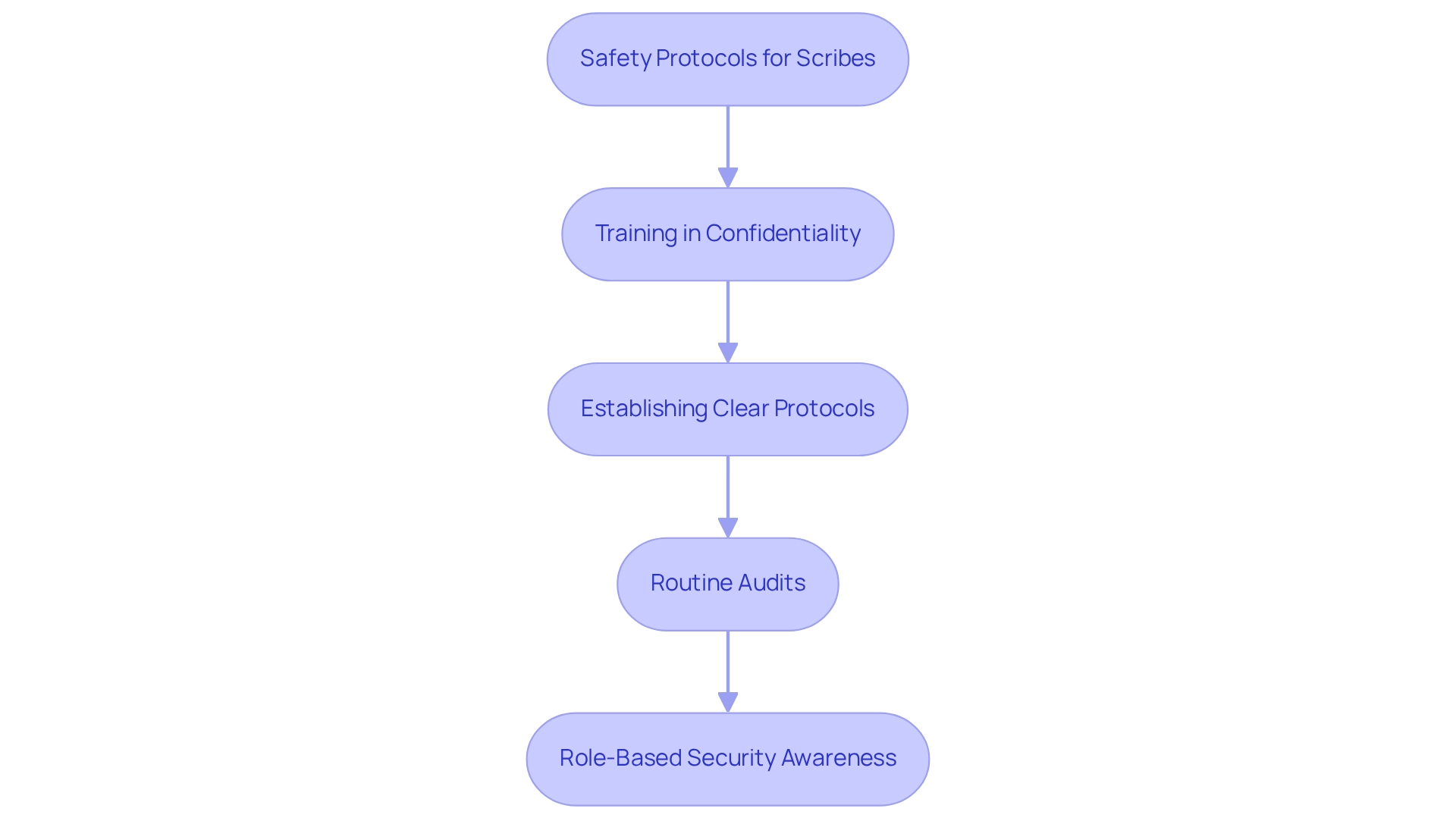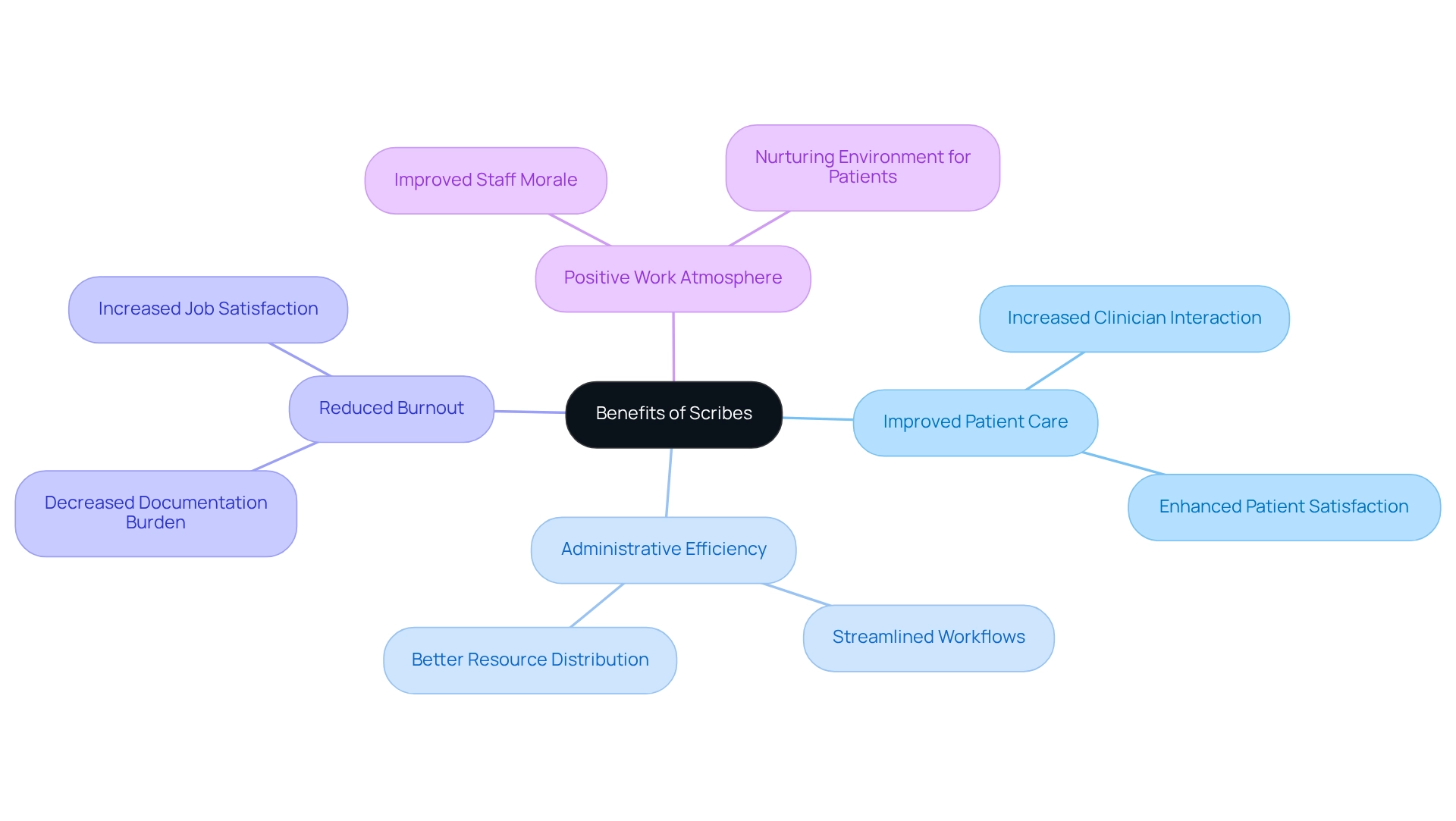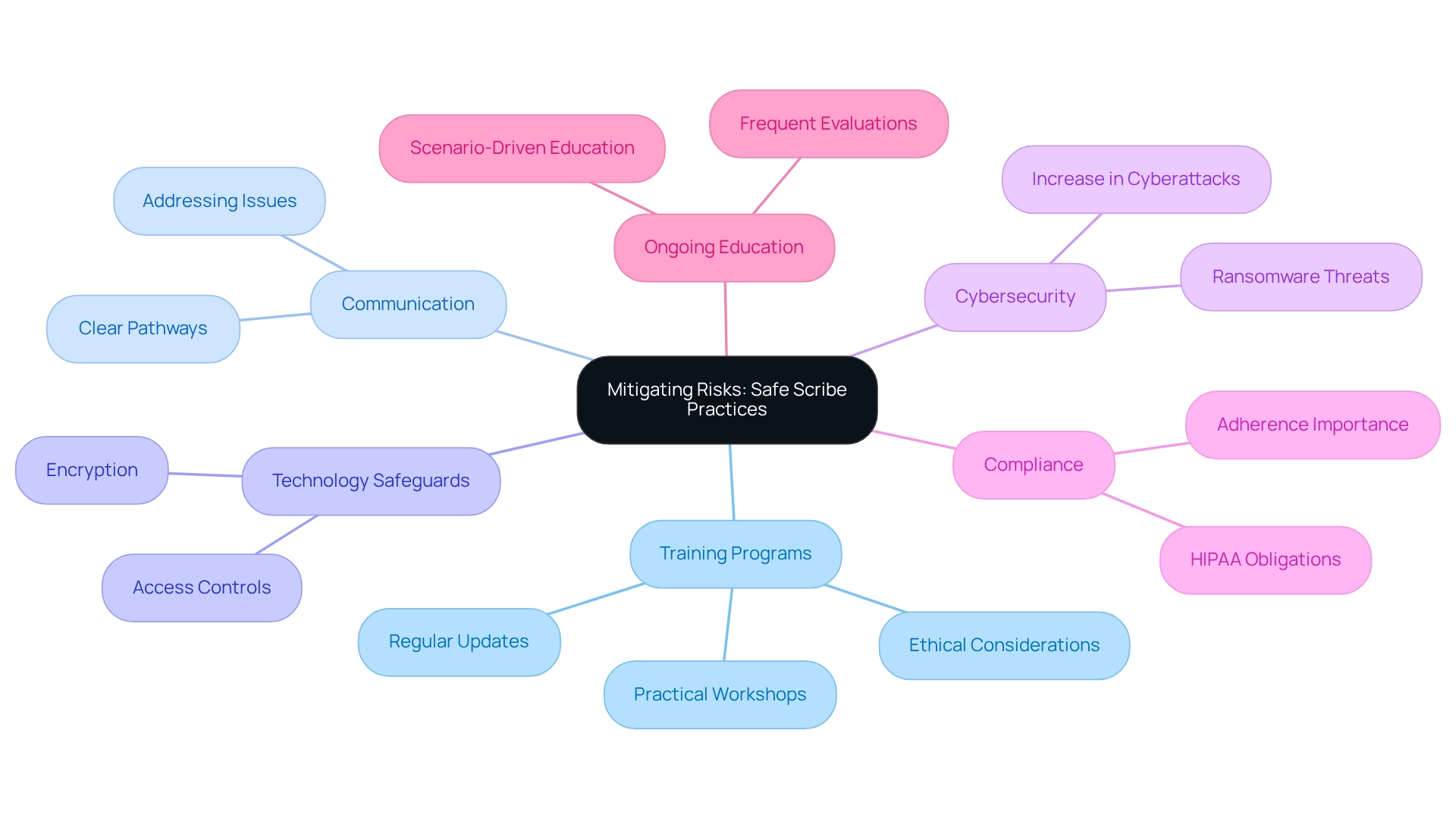Overview
In the demanding world of healthcare, providers often grapple with overwhelming administrative burdens that can detract from the quality of patient care. This is where the thoughtful implementation of scribe usage comes into play. When proper safety protocols and comprehensive training are in place, scribes not only enhance patient care but also streamline administrative efficiency, all while ensuring compliance with essential regulations like HIPAA.
Imagine a scenario where healthcare professionals can focus more on their patients rather than being bogged down by paperwork. This article highlights the importance of thorough training in confidentiality, regular audits, and the integration of technology with robust security measures. These elements are crucial in mitigating the risks associated with scribe documentation, ultimately leading to improved patient outcomes and greater satisfaction among providers.
By embracing these practices, healthcare teams can foster an environment that prioritizes both safety and compassion. Let us work together to ensure that every patient receives the care they deserve, while also supporting our dedicated healthcare providers in their vital roles. How can we further engage in this journey towards enhanced patient care and administrative excellence?
Introduction
In the ever-evolving world of healthcare, have you ever felt overwhelmed by the demands of documentation? The role of scribes has become vital in alleviating this burden, enhancing both patient care and operational efficiency. By meticulously documenting patient encounters in real-time, scribes empower healthcare providers to focus on what truly matters—delivering quality care to those in need.
With the introduction of AI-powered scribes, this role is not just changing; it’s transforming. These innovations streamline administrative tasks, enriching the patient experience and allowing healthcare professionals to dedicate more time to their patients. Yet, with these advancements come significant responsibilities. Adhering to safety protocols and regulations is essential to protect sensitive patient information.
As healthcare organizations navigate this complex landscape, it’s crucial to understand the multifaceted benefits and risks associated with scribes. This awareness fosters a more efficient and patient-centered system, ultimately leading to better outcomes for everyone involved. Together, let’s explore how embracing this role can lead to a brighter future in healthcare.
Understanding the Role of Scribes in Healthcare
Scribes play a vital role in medical settings, providing immediate records of client interactions that allow healthcare providers to prioritize patient care over administrative tasks. By taking detailed notes during consultations, these dedicated record keepers help maintain accurate medical documentation, which is essential for effective treatment and continuity of care. This function becomes particularly crucial in high-pressure clinical environments where time constraints can compromise record quality and, ultimately, patient outcomes.
With the advancement of technology, AI-driven assistants are increasingly being embraced in medical environments. These innovative systems streamline the record-keeping process, covering appointment scheduling, medical record management, and billing. This allows care providers to devote more time to meaningful interactions with patients rather than getting bogged down by paperwork. This shift not only simplifies the provision of medical services but also enhances the patient experience, fostering a more interactive and compassionate environment during consultations while ensuring compliance with regulations like HIPAA.
Current statistics reveal that integrating assistants, particularly in cardiology clinics, has led to significant improvements in physician productivity and revenue generation. Experts also emphasize the importance of real-time documentation in enhancing care outcomes. As medical services continue to evolve, the roles of both human and AI note-takers will be essential in shaping a more efficient and patient-centered medical landscape.
Have you considered how these advancements could alleviate some of the burdens you face? Embracing these tools can lead to a more fulfilling experience for both providers and patients. Let's continue to explore how we can work together to create a nurturing and effective healthcare environment.

Safety Protocols and Regulations for Scribes
Safety protocols and regulations for record keepers are crucial for safeguarding individual information and ensuring compliance with medical laws like HIPAA. Have you ever considered how vital it is for scribes to be trained in confidentiality and data protection practices to ensure that scribe is scribe safe to use? This training is essential to prevent unauthorized access to sensitive medical information. Additionally, healthcare entities must establish clear protocols regarding the duties of assistants, ensuring they refrain from engaging in clinical decision-making or care-related tasks.
Routine audits and compliance assessments play a significant role in overseeing adherence to these regulations. By doing so, we can reduce the risks associated with documentation errors or breaches of confidentiality. As the OCR director wisely noted, "an ounce of prevention is worth a pound of cure," emphasizing the importance of preventive measures in compliance and safety protocols.
Moreover, implementing role-based security awareness training, as highlighted in relevant case studies, can significantly enhance compliance and awareness among staff regarding the necessary physical protections for managing electronic protected health information (ePHI). UpGuard's involvement in managing security postures and monitoring third-party contractors further illustrates the necessity of external oversight in maintaining compliance and security.
By fostering a robust system of safety measures, medical professionals can evaluate if is scribe safe to use while harnessing the benefits of assistants and upholding the highest standards of care and data protection. This is especially pertinent as we look ahead to the evolving regulations for medical support roles in 2025. Together, let’s prioritize these protocols to ensure our patients receive the best care possible while protecting their sensitive information.

Benefits of Scribes: Enhancing Patient Care and Administrative Efficiency
The challenges faced by healthcare providers can often feel overwhelming. Incorporating writers into medical practices offers a compassionate solution, providing multiple advantages like improved care for individuals and greater administrative efficiency. By alleviating the documentation burden on healthcare professionals, assistants enable clinicians to dedicate more time to direct interactions with individuals—an essential component in building rapport and trust.
Research shows that having record keepers present can significantly enhance satisfaction ratings. Patients often feel more cared for during their appointments, which fosters a nurturing environment. Furthermore, the question of whether it is scribe safe to use is important, as scribes play a crucial role in streamlining workflows and reducing the time spent on administrative tasks. This operational efficiency not only helps manage client loads more effectively but also allows for better resource distribution within medical facilities.
As a result, medical providers may experience decreased burnout and increased job satisfaction. This ultimately cultivates a more positive work atmosphere, leading to improved outcomes for those receiving care. If you’re looking to enhance your practice, consider how integrating writers could transform your approach to patient care.

Mitigating Risks: Ensuring Safe Scribe Practices
In the demanding world of healthcare, the emotional challenges faced by providers can weigh heavily. To ensure secure writing practices, medical organizations must implement extensive training programs that address not only the technical aspects of record-keeping but also the ethical considerations involved in patient interactions. Regular training updates are essential to keep record keepers informed about the latest regulations and best practices in data protection.
Creating clear communication pathways between scribes and medical providers is vital for addressing any issues or inconsistencies in documentation. Utilizing technology that includes built-in safeguards, such as encryption and access controls, can further enhance the security of individual data. With a staggering 278% rise in cyberattacks, particularly ransomware, from 2018 to 2023, it's crucial to recognize the necessity for strong cybersecurity measures.
As Steve Alder, Editor-in-Chief, wisely observes, "It is essential to have procedures in place to respond to individuals exercising their HIPAA rights." By promoting a culture of safety and accountability, medical organizations can effectively reduce the risks linked to scribe use and ensure that scribe documentation is safe to use, while enhancing the advantages of increased efficiency and patient care. Additionally, automating specific tasks can alleviate concerns about human errors and lessen labor intensity, ultimately resulting in more precise records.
Consider the case of GoodRx Holdings Inc., which faced a penalty of $1,500,000 for failing to inform consumers about unauthorized disclosures. This example underscores the vital significance of adherence in medical record practices. Optimal methods for training medical writers should incorporate practical workshops, scenario-driven education, and frequent evaluations to ensure competence. Expert recommendations emphasize the importance of ongoing education to adapt to evolving compliance requirements and technological advancements.
By prioritizing these strategies, healthcare providers can ensure that scribe documentation is safe to use and enhance its effectiveness, ultimately leading to better patient outcomes. Together, let’s foster an environment where every detail matters, and every patient feels cared for.

Conclusion
The role of scribes in healthcare is increasingly recognized as essential for enhancing both patient care and operational efficiency. By providing real-time documentation, scribes allow healthcare providers to focus on what truly matters—engaging with patients. The advent of AI-powered scribes further amplifies these benefits, streamlining administrative tasks and enriching the overall patient experience. As healthcare organizations embrace this innovative approach, they can expect improvements in productivity, patient satisfaction, and ultimately, better health outcomes.
However, with these advancements come significant responsibilities. Ensuring compliance with safety protocols and regulations is critical to safeguarding sensitive patient information. Training scribes in confidentiality and establishing robust security measures are paramount in preventing data breaches. By prioritizing these safety protocols, healthcare organizations can mitigate risks while reaping the benefits of improved efficiency and patient interactions.
In summary, the integration of scribes—both human and AI—into healthcare settings represents a transformative shift towards a more patient-centered approach. By alleviating the documentation burden, healthcare providers can enhance their focus on delivering quality care. As the landscape of healthcare continues to evolve, embracing this role will be vital for creating a sustainable, efficient, and compassionate healthcare system that prioritizes the well-being of patients above all else.




